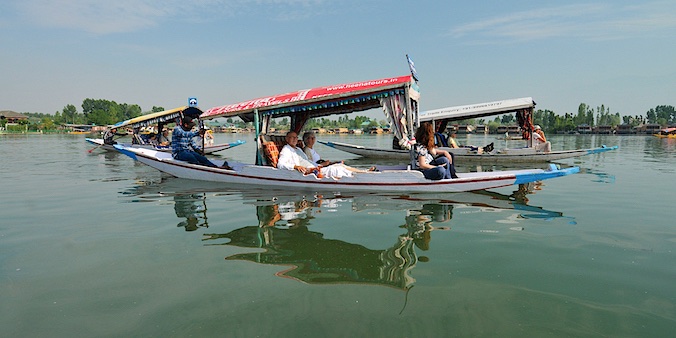Ladakh overland full circle
Tour - 25 days
About LADAKH, Kinnaur, Spiti & Kashmir
Ladakh is a part of the Indian Himalayas It is located between the Kunlun mountain range in the north and the main Himalayas to the south. Although part of India now, and earlier of the princely state of Kashmir, Ladakh has been an independent kingdom for almost 900 years.
Ladakh is well-known for its starkly beautiful mountain scenery. As a result of its location in the rain shadow of the main Himalayan Range its climate is extremely dry, and due to the high altitude – most valleys are situated at 3300m or higher – winters can be extremely cold. Summers, however, are generally pleasant if not warm and sunny. Ladakh is inhabited by a mix of Indo-Aryan and Tibetan people. Especially the latter, with their colourful buddhist culture, have given the region the nickname of ‘Little Tibet.’
Ladakh in the narrower sense is the Indus Valley with adjacent areas. It is bordered by two mountain ranges: in the northeast by the Ladakh Range, in the southwest by the Zanskar Range. The area around the capital Leh, and further upstream towards Tibet, is referred to as Upper Ladakh. Lower Ladakh is the area further downstream to Kargil, where the Indus enters Pakistan.
The remoter areas of Zanskar, Nubra and Rupshu are now seen as regions of Ladakh. In the past, these areas were sometimes part of Ladakh, sometimes not. They can be visited from Leh by car or on foot. The latter would be your means of transport, if you are up to it. Because, while jeep trips in Ladakh are very rewarding indeed, trekking will give you an even in-depth experience of the land and the people, with the added bonus of a total renovation of body and soul.
Ladakh can be reached by air or overland. This tour takes you by train and car to Ladakh through the regions Kinnaur and Spiti, both in the state of Himachal Pradesh. Kinnaur is the area around the Sutlej, one of the four large rivers that originate on the flanks of holy Mt. Kailash in Tibet. It is an area of steep mountain sides and a culture that XXX.
Spiti is part of the Trans-Himalaya, the area north of the Himalayan Range of which Ladakh and Tibet are also part. It has a purely Tibetan culture, language and religion (Buddhism). As the Sutlej has found a way to break through the Himalayan Range, following his river upstream is the only access route to the Indian Trans-Himalaya that does not involve crossing one or more high passes. This makes Spiti the most accessible ‘Tibetan’ region in India.
Region
Ladakh
(India)
Best Time
July - Sept.
No. Of Days
20 Days
Trip Character
Jeep tour with walks
Sleeping Altitude
2350 - 4300 m.
Price
INR XXX/ $ XXX
ABOUT THIS TOUR
On this tour you will visit Ladakh and its borderlands in the most complete way: overland, full circle. You’ll travel in over land, through Spiti, and out over land as well, through Kashmir. You’ll visit Kinnaur, Spiti, Nubra, Pangong Lake, Leh and he Indus Valley, the remote area of Zanskar and last-but-not-least idyllic Dal Lake near Srinagar.
First, you’ll travel by train and car to Shimla, once the summer residence of the British in India. Then you’ll follow the river Sutlej through the Kinnaur region up to Spiti. You will experience an astonishing transition from green and wooded to barren and desolate, and also the from Hinduism to Buddhism.
Spiti is a kind of ‘little Tibet’ in India, with beautiful Buddhist monasteries and breathtaking landscapes. Here, you can optionally do a three- or four-day trek along some very picturesque and high altitude villages above the Spiti Valley.
Then you will cross the Himalayan Range to Ladakh on the Tibetan Plateau.
After you reach Leh, the capital of Ladakh, you will explore the borderlands near Tibet. You’ll spend three days in a pleasant lodge in the middle of a traditional village. From there you will visit the cobalt blue high lake Pangong Tso. Via the much sung Nubra Valley, an isolated valley wedged between India, Pakistan and Tibet, you will reach Leh again.
After two days in Leh, you’ll do a four-day trek through an unpaved part of Ladakh. Then you’ll travel by jeep via Kargil to the remote valleys of Zanskar. Returning via Kargil you will cross the Himalayan Range again, this time southward, to Kashmir. On the idyllic Dal Lake you can relax two days on a houseboat and process the many impressions of your trip before you fly or ride out to Delhi.
YOUR custom-made TRIP
The tour described here, as well as the other ones on our website, are mainly meant as suggestions. We would be happy to offer you a travel proposal that fully meets your personal demands and expectations. That means that you choose where you want to go, what level of accommodation and type of transport you want and what activities you prefer.
Please let yourself be inspired by this and other trips on our website and then drop us a line (or call us up) to explain your travel wishes. We will be happy to help you put together the perfect trip. You can send us an e-mail or call us over Whatsapp.
EXTENSIONS & VARIATIONS
Apart from the tour as described here, you could consider the following add-ons and changes:
- After reaching Leh do a 6-day exploration jeep tour to Nubra Valley, Shyok and Pangong Tso.
- Do a trek in in the Indus Valley near Leh. For instance the easy but rewarding 4-day Sham Trek See here. You sleep in homestays where you get to meet the Ladakhis up-close. Or the more demanding 5-day trek from Chilling to Lamayuru. On this trek you sleep in trekkers tents while a walk-along cook prepares your meals. You walk longer distances, climb higher passes but the rewards are even better views, more authentic villages. See here.
- Spend a day rafting on the Indus. There are different grades available, so there is the easy but fun to do level as well. Professional oarsmen will be with you in any case. You will be picked up from your hotel and dropped off there again at the end of the day, a pic-nic lunch is included.
ITINERARY
-
Day 1: New Delhi - Chandigarh - Shimla (4 h train, 3 -4 h car)
Your journey starts with a 4-hour train ride from Delhi to Chandigarh. Here, our driver is waiting to take you up into Shimla, situated at 2275m in the Himalyan foothills. Altitude 215 → 2200m. -
Day 2: In Shimla
Today you'll do some relaxed sightseeing, including a visit to the splendid Viceregal Lodge, a castle-like gothic structure, and the nearby Himachal State Museum, a colonial building with some interesting collections of miniatures, stone sculptures, handicrafts, etc. Altitude 2200m. -
Day 3: Shimla - Sarahan (7 - 8 h)
Today we enter Kinnaur, a region with magnificent mountain scenery and interesting local architecture. The route through the Satluj Valley with its many apple orchards takes us through several small towns, like Nirth, with an old Sun God temple. Altitude 2200 → 2680m. -
Day 4: Sarahan - Sangla (4 - 5 h)
Going to Sangla (2680 m) takes about 4 to 5 h on a well-surfaced road. The small town, with a temple and a nearby fort, has a majestic setting in a deeply carved valley surrounded by snowy summits. Altitude 2680 → 3450m. -
Day 5: Sangla - Chitkul - Sangla
This daytrip starts with a steep climb along a narrow road to beautiful Chitkul (3450 m) with a 500 years old temple. Another village to be visited is Rackcham, which has a striking location, surrounded as it is by granite cliffs and forests. Altitude 3450m. -
Day 6: Sangla - Rarang (6 h)
After a descent to the Sutlej river we continue upstream until we reach the beautiful village of Rarang. On the way we pass many orchards and vineyards and visit Ribba, famous for its ‘angoori’ (grape wine). Additionally Kanum can be visited, a monastic village with seven temples. Altitude 3450 → 2650m. -
Day 7: Rarang - Tabo (6 h)
Today we ‘cross’ the Himalayas through a deep gap cut by the Satluj river and reach Khab, where the Spiti river joins the Satluj. From here – high above the dramatic Spiti gorge - the roads zigzags 1200 m up to Nako (3660 m), and continues to Tabo (3280 m). Nearby Tabo Gompa counts as one of the most important temples in the Tibetan cultural area. A gompa is a Buddhist monastery and/or temple. Altitude 2650 → 3050m. -
Day 8: Tabo - Shego/ Kaza (5 h)
Driving along the Spiti Valley we pass many villages and monasteries. Before reaching the capital Kaza we make a side trip to Pin Valley National Park, famous for its wild life which includes ibex and the shy snow leopard. Time permitting, we also visit spectacularly located Dankar (3900 m), former capital of an old Spiti kingdom. Overnight at Shego near Kaza. Altitude 3050 → 3600m. -
Day 9: Visit high villages
By jeep we visit several interesting high villages with striking locations. Doing a short trek is possible too. See two highlights. Very picturesque is Ki Gompa, which belongs to the Yellow Hat Sect and is one of the biggest and the oldest monasteries in Spiti. Altitude 3600 → 4300 → 3600m. -
Day 10: Shego - Chandratal (5 - 6 h)
We cross the Himalayan Range (again) as we drive over Kunzum pass (4550 m). Soon we take a narrow track to Chandratal (4270 m). The first sight of this wondrous ‘Moon Lake’ takes one’s breath away. Massive mountaintops and glaciers dominate the lake with shores carpeted with alpine flowers. Camp next to the lake. Altitude: 3600 → 4250m. -
Day 11: Chandratal - Serchu (6 - 7 h)
We are in the Lahaul-region now and join the Manali - Leh Highway. The next two days you will drive over high passes, winding roads and hairpin bends, sometimes crossing landslides and small rivers. This is one of the most spectacular mountain roads in the world! First we pass many Lahauli villages surrounded by fields of potato and peas with snowcapped mountains all around. Then a long climb leads to the Baralacha La (4890 m). Here you cross the Himalayan chain (again) and enter the immense no man's land of the Trans-Himalaya with beautifully coloured mountains. Beyond are the Lingti Plains, where you overnight in a tented accommodation. Altitude 4200 → 4890 → 4200m. -
Day 12: Serchu - Leh (8 - 9 h)
The road climbs to the next two passes, including the Lachalung La (5060m) and soon you may see nomads wandering around with goats and yaks. After crossing the very high Taglang La – 5300 m - you reach the actual Ladakh. You pass the first Ladakhi houses, white painted and made of stamped clay. Yaks, prayer flags, stupas and green barley fields complete the Tibetan atmosphere. Soon the legendary Indus river is reached. Overnight in Leh in a comfortable guesthouse. Altitude 4200 → 5300 → 3600m. -
Day 13: In Leh
Leh is a pleasant little city with many restaurants and shops, and opportunities for short walks. Highly recommended are excursions by taxi to some of the many nearby Buddhist monasteries. Altitude: 3600m. -
Day 15 - 20: Suggested: Jeep tour Nubra Valley
After reaching Ladakh, you obviously would want to explore this. Fascinating place. We suggest, as a minimum, do do a 6-day tour of Nubra and Pangong Lake. See here. -
Day 20: In Leh
A last day in Leh to buy souvenirs and to get organised for the last leg of the journey. -
Day 21: Leh - Kargil (5 - 6 h)
You leave Leh to the northwest and follow the Indus River to Khaltse and then past Lamayuru to Kargil. -
Day 22: Kargil - Srinagar (7 - 8 h)
A potentially long drive takes you back over the Himalayan Range to Srinagar in Kashmir. Crossing the main pass, the 3528m high Zoji La, is a spectacular, if not nail biting experience. In Srinagar, you stay at a houseboat on DalLake. -
Day 23: In Srinagar
Today you can relax on picturesque Dal Lake, or take boat rides in a shikara (wooden peddle boat) on the lake. -
Day 24: In Srinagar
XXX. -
Day 25: Srinagar - Delhi
HIGHLIGHTS OF THIS TOUR
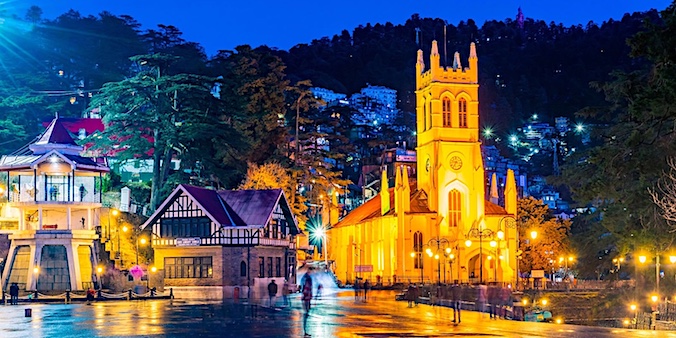
SHIMLA
SUTLEJ GORGE (KINNAUR)
The Sutlej (or Satluj) River is one of the five rivers that originate near the sacred Mount Kailash in Tibet. The 1450 km long river enters India near the 3930 m high Shipki La in the state of Himachal Pradesh. Near this entry point the powerful river managed to cut a dramatically deep gorge right through the Himalayas. From there on it wrestled its way through beautiful Kinnaur. Today, after a long journey it reaches the flats of Indian Punjab, enters Pakistan, empties itself into the mighty Indus river and finally reaches the Arabian Sea. In the remote valleys of Kinnaur local principalities and cultures came into existence, made possible by fertile soils, good climate, and strategic locations for defence and trade.
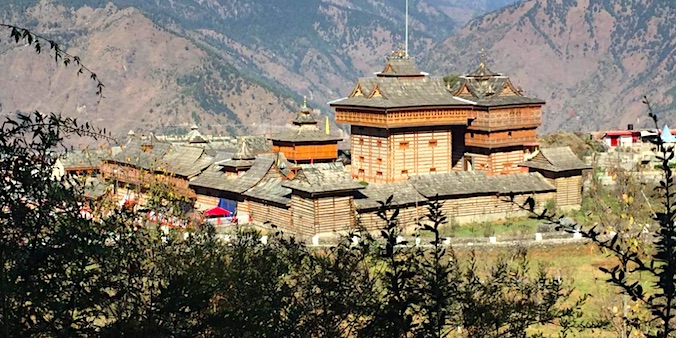
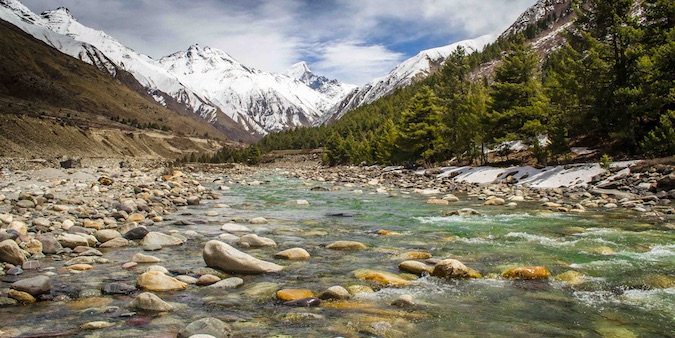
SANGLA VALLEY
Tabo Gompa
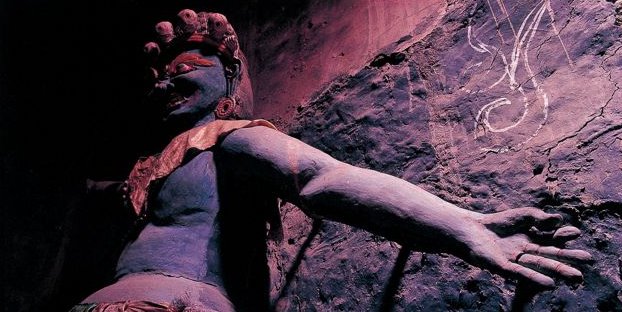
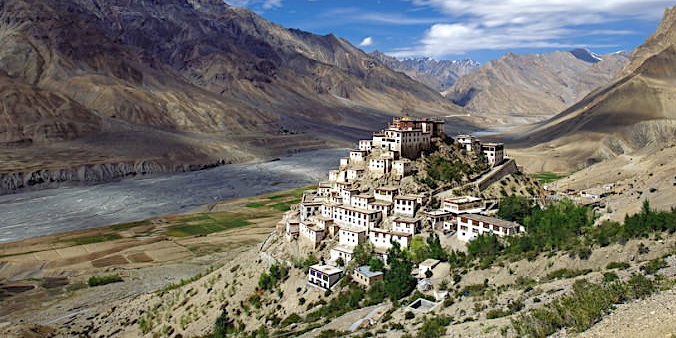
Spiti Valley
This 150 km long valley is located northeast and in the rain shadow of the Great Himalayan Range. This has resulted in a dry mountainous moonscape of stark beauty interspersed with oasis-like villages. In many places fortress-like gompas, situated on a hilltop or a protruding section of a mountain, dominate the valley. Until not so long ago – before the road from Shimla was constructed – Spiti was difficult to reach from India proper, but it was well connected through trade routes with neighbouring Buddhist Tibet and Ladakh, with which it has always maintained strong cultural and religious ties with Tibet. The dialect spoken in Spiti is very similar to that of Southeast Tibet.
High Villages of Spiti


HIMALAYA CROSSING - KUNZUM LA
Between Spiti and Ladakh you will cross the Himalayan Range twice. This awkward fact is due to a bend in the Himalayan Range. Leaving the high valley of Spiti behind, you first climb to the Kunzum La (xxxm). Then you descend to the town of Keylong (3000m) in Lahaul. The next day you again climb up to a Himalayan pass, this time the Baralacha La (xxxm). Ony after crossing this pass you’ll enter the high altitude plain of Changtang in eastern Ladakh. Because the area is to high for agriculture, there is hardly any inhabitation. You may see nomads wandering around with their goats and yaks. The goats produce the extremely warm pashmina wool, out of which the famous cashmere woollens are woven.
Chandratal
P.M
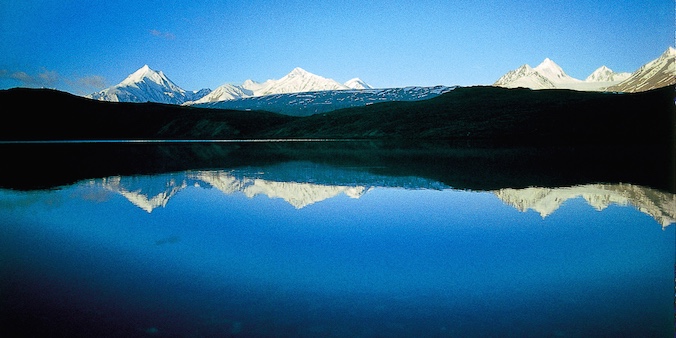
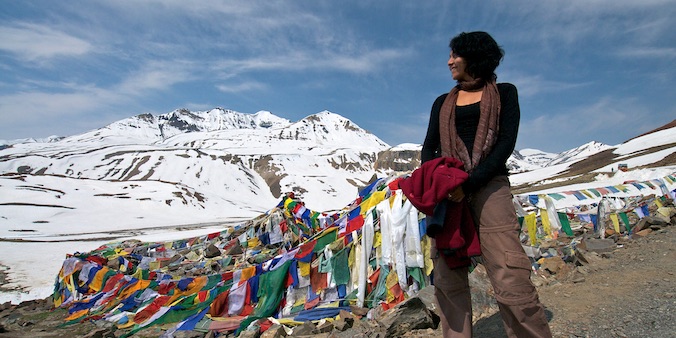
HIMALAYA CROSSING - BARALACHA LA
LEH
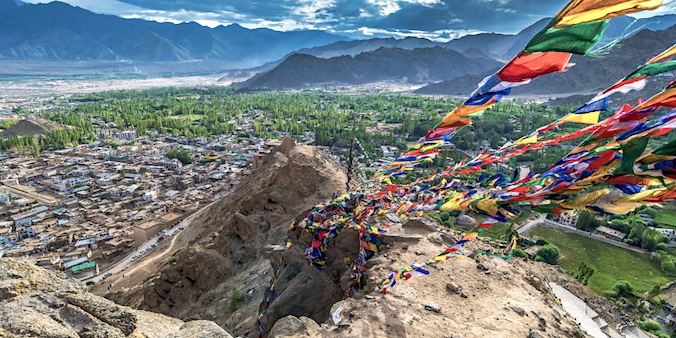
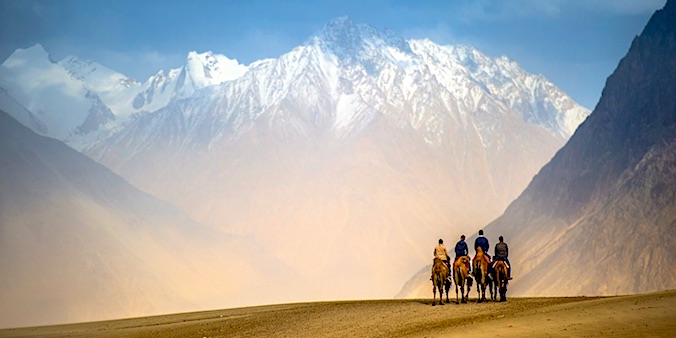
NUBRA VALLEY
Nubra Valley is an idyllic enclave between the mountains of Ladakh and the famous Karakoram. The main highlight here are the many small villages, hidden between poplars and apricot groves and adorned with an abundance of stupas, mani walls and prayer wheels. Definitely worth visiting as well are the beautiful gompas (monasteries), such as 15th century Deskit Gompa, with commanding views over the valley. While in Nubra you may bump into some of the large bactrians, two-humped camels that are descended from the animals that used to work the caravan trails between Leh and Yarkhand (Turkmenistan, now China). Riding the bactrians over the extensive sand dunes near Hundar is like being a Sahara traveler.
SHYOK RIVER LODGE

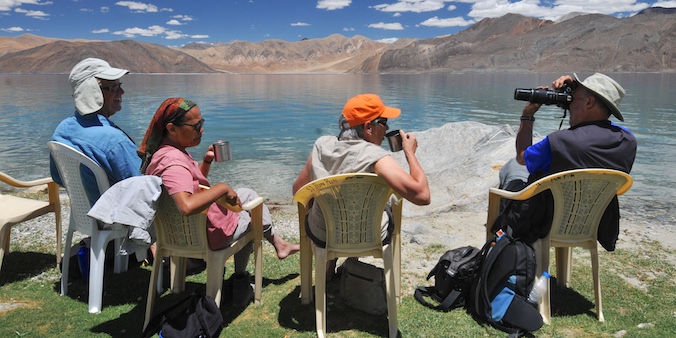
PANGONG LAKE
SHAM TREK

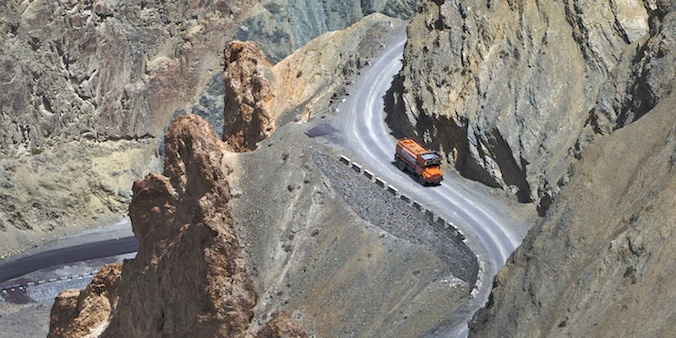
LOWER INDUS VALLEY (WEST)
The Indus Valley to the northwest of Leh is definitely an area worth exploring while you are in Leh. Some of the most picturesque and atmospheric Buddhist monasteries are found here, notably Phyang, Likir, Ridzong, Alchi and Lamayuru, as well as the burrough temple of Basgo.
The road passes through some pretty spectacular mountain scenery that makes the drive in itself more than worthwhile. You’ll drive over desert plateaus, alongside the Indus River in the gorge that is has carved out for itself and on seemingly never ending switchbacks clinging to steep mountain slopes.
LAMAYURU & ALCHI GOMPA

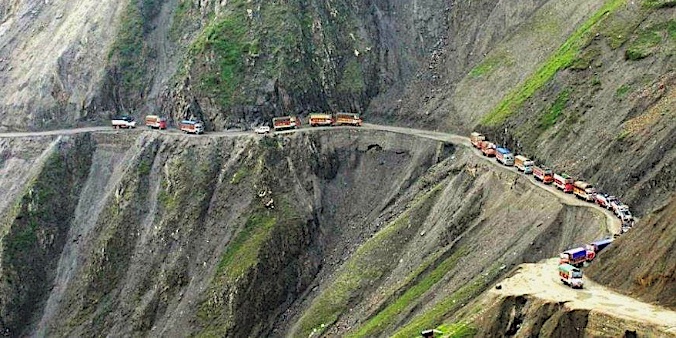
THE ROAD TO LADAKH
Dal Lake
Dal Lake is a lake near Srinagar, the summer capital of Jammu and Kashmir, India. Named the “Lake of Flowers” or the “Jewel in the crown of Kashmir” it is indeed an idyllic place. Here, you’ll stay in a floating hotel built in nineteenth century British cottage style. On this houseboat, you’ll be surrounded by quiet waters and the subtle sounds of splashing peddles of passing shikaras (small, wooden boats; only non-motorized boats are allowed here), kingfishers, pariah kites and other water birds. Due to the cold, oxygen-rich water that flows into it from the river Jhelum the water is clean and very productive in terms of water plants and fish. Both are being harvested, an important source of income for part of the local population.
